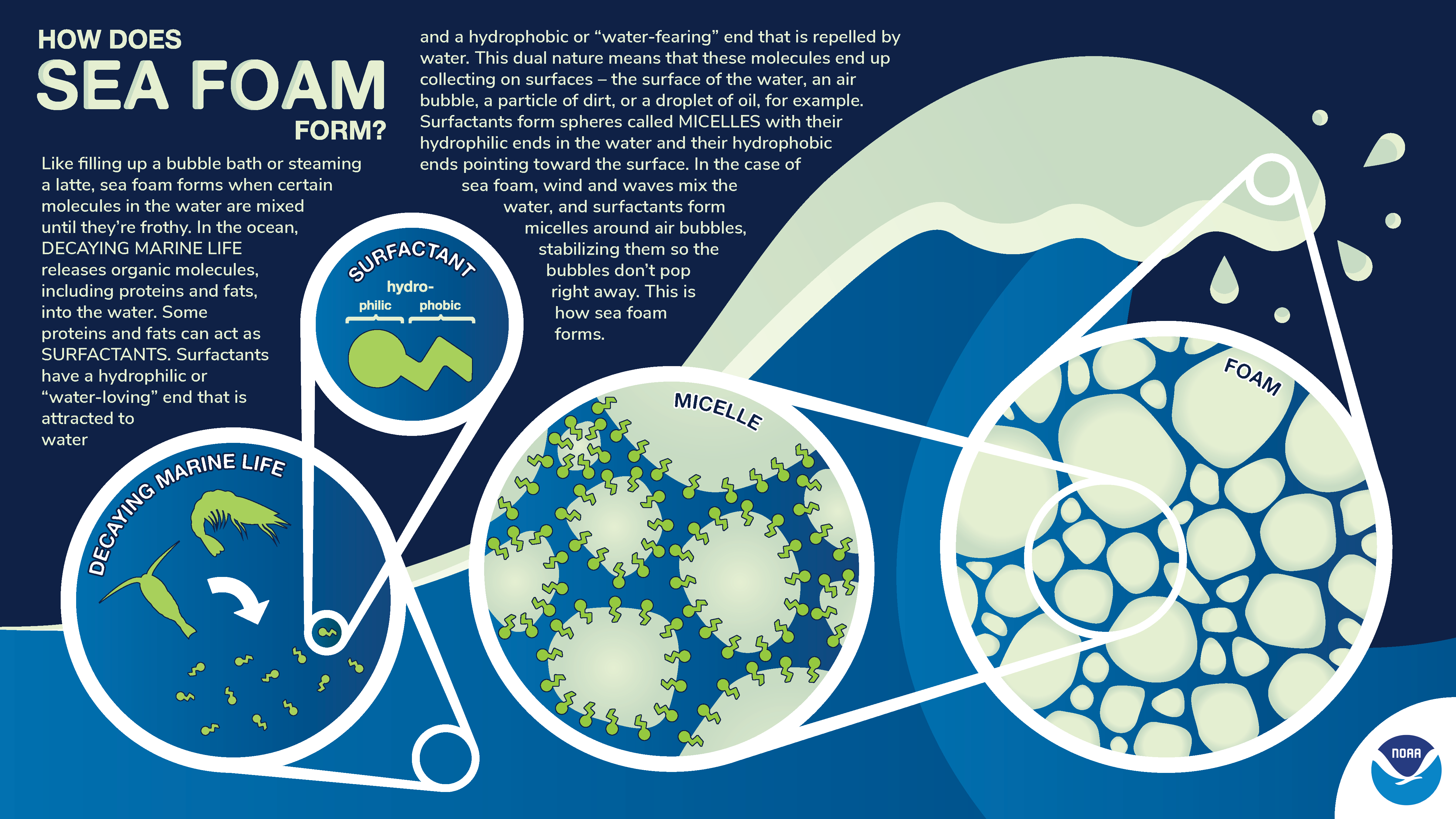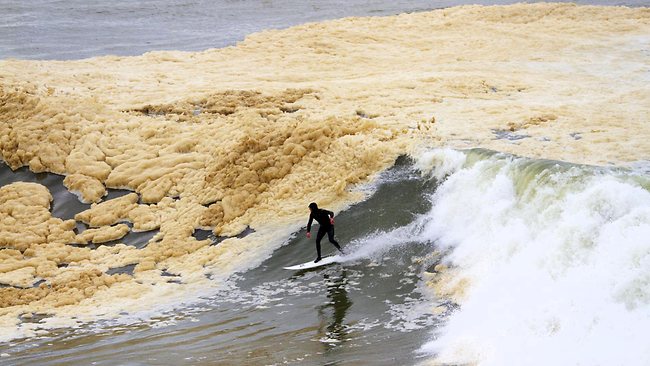While the foam is generally non-toxic, arising from the agitation of organic matter in the ocean, people do not swim in the foam when advisories are in place Is Sea Foam Safe for Water Sports and Beach Safety?
Sea foam is generally safe but check water quality. Excessive foam might indicate organic matter. Be cautious, consider allergies, and follow local guidelines or warnings for water safety during water sports and beach activities.
Understanding Sea Foam: Is it Safe for Water Sports and Beach Safety
Understanding sea foam is crucial for ensuring water sports and beach safety. While sea foam itself is generally harmless, it can sometimes indicate the presence of pollutants or harmful algae blooms, posing risks to swimmers and water sports enthusiasts.
Before engaging in activities, it’s advisable to check for any advisories regarding water quality and potential hazards associated with sea foam. Additionally, being cautious around large accumulations of foam, especially in areas with known pollution concerns, can help mitigate any potential health risks. Overall, staying informed and exercising caution when encountering sea foam can contribute to a safer and more enjoyable experience at the beach.
How Foam Forms on the Sea: Understanding Ocean Content
Amid the vast and mysterious brine, one spectacle that often catches our eyes on the shoreline is the frothy substance that collects in breaking waves, a phenomenon as whimsical as the ocean itself. This foam, these foam bubbles, are nature’s little marvels, though the chemistry behind them is quite elementary. Sea foams or the type of foam sea-wise beachgoers might notice, start their journey with the churning of seawater, particularly when tumultuous storms stir the ocean’s content, producing a mousse of ocean foam. But what exactly spawns this sudsy occurrence?

The answer lies with surfactant molecules, which are substances that decrease the surface tension of the water, allowing air to become trapped between the water molecules and forming the countless bubbles we observe.
The surfactant materials can be organic, stemming from the decomposition of plant and animal material in the water, or man-made, washed out from various sources into the sea.
As these bubbles congregate, they’re guided ashore by wind and wave, arriving as a bubbly carpet greeting those who venture onto the sands—it’s a process as natural as the wind that shapes dunes, as intrinsic to the sea as the tides that oscillate like a celestial metronome.
When assessing water quality, seeing sea foam can be both innocuous and a bellwether. Typically, the foam is harmless, composed of just water and the natural compounds mentioned earlier. However, at times, water can contain pollutants or toxins, especially during algal blooms, which can give rise to a particular kind of sea foam. It’s not typical, but it’s wise to consider when planning your next water sports adventure or ensuring beach safety.
Most times, the sea foam is no threat to humans, and we frolicking in or on the water needn’t fear inhaling sea foam particles in moderate amounts. Yet, if the water is tainted by algal blooms—which can contain harmful toxins—the froth may not be as benign. Monitoring beach advisories and being aware of unusual colors or smells can be a good practice to ensure one’s seaside escapades aren’t just memorable but also safe.
For the water-loving community—surfers riding the crests, children constructing kingdoms in the sand, and families relishing the seaside serenity—the foam sea gifts are more than just a quirky occurrence; they’re part of the ocean’s narrative. Bubbles after bubbles, from the smallest to the ones enveloping your feet, all tell a part of the seawater’s tale, a natural artistry composed of water, salt, organic matter, and the breath of the sea itself. These elements combined can make Sea Foam happen in a minute.

The Impact of Sea Foam on Beach Safety and Water Sports
Sea foam can have a notable impact on beach safety and water sports, as it often conceals potential hazards beneath its frothy surface. The accumulation of foam can obscure underwater obstacles, posing risks to swimmers and water sports enthusiasts. Additionally, the altered visibility caused by sea foam may complicate rescue efforts, emphasizing the need for caution and heightened awareness in coastal recreational activities.
When the ocean whips up a lather of soap-like foam, beach enthusiasts and water sports aficionados often find themselves questioning the safety of diving into these frothy waves. On the whole, most sea foam is not harmful to humans, it’s a natural occurrence in our oceans, akin to a bubble bath made by Mother Nature herself. It’s the stuff of marine wonder, this foamy blanket that sometimes covers the beach, offering a unique spectacle for beachgoers. However, there are instances where sea foam can be dangerous, particularly during certain marine conditions or when pollutants have tainted the water.

While the foam is generally non-toxic, arising from the agitation of organic matter in the ocean, people not to swim in the foam when advisories are in place. This is often due to the potential presence of harmful algal blooms, which can produce toxins that may pose a threat to human health.
Even though most of it is harmless to humans, caution should be exercised, especially in areas unfamiliar to the swimmer. Boating through thick sea foam can also pose navigational hazards, potentially obscuring obstacles, and reducing visibility for the operator
In the realm of water sports, sea foam can impact both the safety and enjoyment of activities. Surfers might find themselves riding a stronger break or losing visibility in a curtain of foam, whereas kayakers and those engaged in boating might find their vessels becoming more difficult to control in the sudsy water.
Swimming through dense, foamy waters can impede visibility and movement, which for those not as strong swimmers, could quickly take a turn from being an enjoyable experience to a dangerous one. Beach safety officers often issue directives advising people to keep a safe distance from the foamy shoreline, especially during stormy weather when rip currents can be veiled by the fluffy ocean froth.
The ocean, in its vast majestic ebb and flow, forms sea foam from dissolved organic material, a process that’s typically not harmful to humans. Despite the picturesque scene it sets, it’s crucial to heed marine advisories that may signal unusual or hazardous conditions. Safe practices in and around sea foam should be paramount for everyone in the vicinity of the ocean and its wondrous, yet sometimes unpredictable, nature. The consensus is, that while you may frolic in the foamy edges of the ocean, it’s always better to err on the side of caution.
Ensuring beach safety in the presence of sea foam involves awareness and understanding of the local marine environment. Keep in mind that even if the foam is generally non-toxic, the ocean can often be a trove of unpredictability with currents and tides that are unforgiving. Whether you’re swimming, engaged in boating, or indulging in any form of water sports, recognizing when sea foam may be potentially dangerous is key to a safe and enjoyable beach experience. The ocean, after all, demands respect, and part of that respect involves the due diligence of ensuring your safety amidst its ever-changing conditions.

Exploring Marine Life: Posts on Sea Foam and Taylor Swift’s Ocean Advocacy
Embarking upon a journey to understand marine life brings us to the enigmatic world of sea foam, a phenomenon that froths at the edge of our vast seas. Sea foam, in its effervescent splendor, dances upon the shoreline, a nature’s spectacle that has posed questions about its implications on beach safety and its compatibility with the fervor of water sports.
The foam that we witness by the sea is formed by the agitation of seawater, particularly when organic and synthetic matter is churned up by the waves. This frothy exhibition, which can range from stark whites to hues corrupted by pollutants, reveals a complex side of marine and ocean facts, compelling us to ponder its mysteries.
While sea foam adorns the bay, it also carries a message about the health of our oceans. As such, it’s essential to sift through posts and content that expound on the relationship between sea foam and the environment. The presence of sea foam is a natural occurrence; however, when excessive, it may signal underlying issues. Swept across the beaches, it’s not just foam we observe, but a narrative of the sea, reflecting the interaction between organic life and human activities that bear upon its essence.
Amidst conversations about sea foam and its role in marine ecosystems, Taylor Swift emerged on the red carpet as an unexpected champion for ocean advocacy. Swift has utilized her platform to raise awareness, intertwining dazzling celebrity with the somber realities of marine conservation. Her voice, a clarion call sounding beyond the pages of tabloids and into the heart of oceanic preservation, aligns with the services needed to protect our marine sanctuaries—further illustrating that star power can harness the winds of change for global seas.
The harmony between sea foam and recreational activities at sea, such as surfing or kayaking, often hinges on the understanding that comes with education. Seeking out information that sheds light on the origin and behavior of foam at sea can empower enthusiasts and professionals alike to harmonize their passions for the ocean.
Our dedication to exploring posts about sea foam has led to a greater grasp of how marine life asserts itself through these foamy manifestations. In an era where the privacy of secluded bays is sought after, and the red-carpet events often take precedence in the media, it’s essential to parallel this limelight with the pressing needs of our seas.
Incorporating the ABCs of oceanic information into our daily search expands our understanding and fosters an environment where sea foam, be it abundant or scarce, is recognized not merely as a byproduct of nature’s churn but as an invitation to safeguard our marine ecosystems.
Conclusion:
Sea foam is a natural phenomenon caused by the agitation of organic matter in seawater, resulting in the formation of bubbles. In most cases, sea foam is harmless and occurs regularly in coastal areas. However, it’s essential to consider certain factors before engaging in water sports or beach activities in the presence of sea foam.
- Origin: Sea foam can be generated from various sources, including decaying algae or organic matter. While most sea foam is harmless, it’s crucial to be aware of any potential contaminants in the water.
- Conditions: If sea foam is excessive, it might indicate higher levels of dissolved organic matter. In such cases, it’s advisable to exercise caution, especially if the foam has an unpleasant odor or discoloration.
- Allergies and Sensitivities: Some individuals may be sensitive or allergic to certain substances present in sea foam. It’s important to be aware of personal allergies and take necessary precautions.
- Water Quality: Check the overall water quality and whether the beach has been deemed safe for swimming and water activities by relevant authorities. Elevated levels of pollutants or harmful microorganisms can be associated with excessive sea foam.
- Local Guidelines: Follow any guidelines or warnings provided by local authorities regarding water safety. They may issue advisories if there are concerns about water quality or potential hazards associated with sea foam.
Always prioritize your safety and the safety of others when engaging in water sports or spending time at the beach. If you have specific concerns about the sea foam at a particular location, it’s recommended to consult with local authorities or lifeguards for up-to-date information on water safety conditions.
Reference:
News.com AU-Foam’s up as surfers brave massive murky-brown waves
FAQ’s




